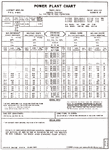Shortround6
Lieutenant General
There was a mock up of a Mosquito with a turret and one if not Beaufighters were built with turrets.Had they ever expressed a lack of interest in the turret? Retroactively, I know their interest had faded with time...
The Mosquito didn't get a two stage supercharger for several years. Altitude performance of a single Stage Merlin was good but critical height (FTH) was around 21-22,000ft.One could use the same argument for the NF Mosquito... as time goes on, it's generally natural to try and squeeze as much speed and altitude out of a design. This is for numerous reasons, the first being that threats improve with time.
[QUOTE ] Additionally, I figure a turbocharger would add range[/QUOTE]
It turns out they they did but that was unknown during the planning stages.
[QUOTE ] I honestly have little knowledge as to the P-47's issues with its turbocharger.
That's a good observation, I missed that: Regardless, the P-47M was available by 1944 right?[/QUOTE]
Most of the troubles were in the P-47B version which stayed stateside as trainers (and development aircraft) The P-47 was the first version to go overseas after more than 500 "B"s were built.
Even as a rush job the first P-47Ms didn't make to England until Dec of 1944. And they had so much trouble with them that they weren't declared operational until March or April of 1945.
We have to be careful with the "Retrospectoscope". We know when different engines or fuels became available. In 1941 when decisions on which engine to use had to be made they had no practical experience with either engine and no firm idea when improved models would be available.

